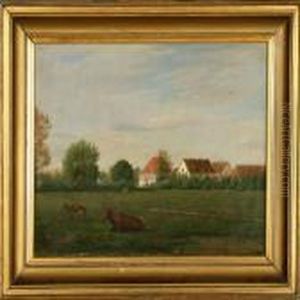Frederick Christian Lund Paintings
Frederick Christian Lund was a notable Danish artist, born in 1826, whose body of work significantly contributed to the art scene of the 19th century. Lund's artistic journey began in his early years, deeply influenced by the cultural and artistic environment of Denmark. He pursued his passion for art with rigorous training, which laid the foundation for his distinctive style and approach to painting.
Throughout his career, Lund was known for his remarkable versatility, exploring various subjects ranging from portraits and landscapes to historical and genre scenes. His ability to capture the essence of his subjects with realism and emotional depth won him acclaim and a dedicated following. Lund's landscapes, in particular, were celebrated for their atmospheric quality and meticulous attention to detail, reflecting his profound appreciation for nature.
Lund's contribution to Danish art was not limited to his own creations. He was an active member of the artistic community, participating in exhibitions and engaging in cultural debates of the time. His works were frequently showcased in art exhibitions, earning him recognition and awards, which helped to cement his reputation both in Denmark and internationally.
Despite the acclaim, Lund remained dedicated to his craft, continually refining his techniques and exploring new themes. His relentless pursuit of artistic excellence and his commitment to capturing the beauty and complexity of the human experience made him a respected figure among his contemporaries.
Frederick Christian Lund passed away in 1901, leaving behind a legacy that has continued to inspire artists and art enthusiasts alike. His contributions to the art world are remembered for their technical skill, emotional resonance, and the vivid portrayal of 19th-century life. Lund's work remains an integral part of Denmark's cultural heritage, celebrated for its enduring appeal and historical significance.



































